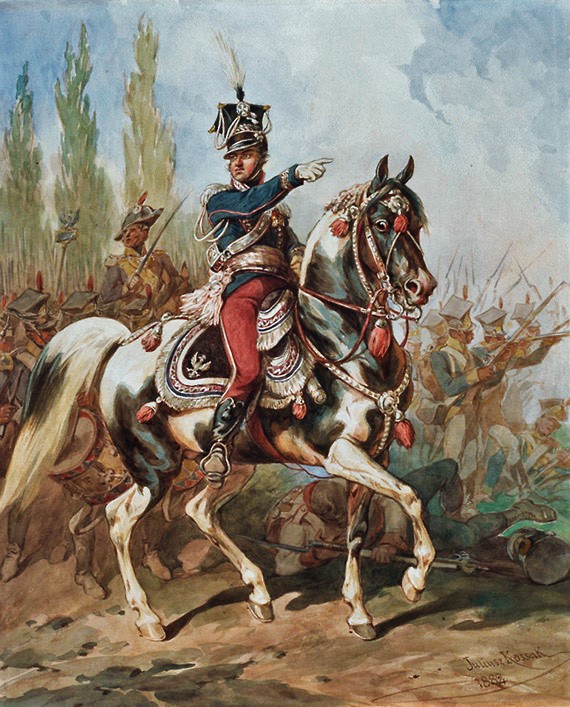|
Battle Of Łabiszyn
The Battle of Łabiszyn took place during the Kościuszko Uprising, on the night of 28 and 29 September 1794, between Military of the Polish–Lithuanian Commonwealth, Polish–Lithuanian insurgents commanded by General Jan Henryk Dąbrowski and Prussian Army, Prussian troops commanded by Colonel Johann Friedrich Székely, ending in victory for the Poles. It was fought on a hill near Łabiszyn, in South Prussia, Kingdom of Prussia (now part of Poland). History During his Greater Poland uprising (1794), expedition to Greater Poland, General Dąbrowski decided to concentrate his troops in Gniezno, where he arrived on 27 September 1794. His force of about 7,000 men consisted of Dąbrowski's division and the Greater Poland insurgents, an army composed mainly of recruits and inexperienced soldiers. With his forces too weak to take Poznań, he decided to feign a march in that direction, and in the meantime destroy Colonel Székely's pacification unit, consisting of a battalion of Fusil ... [...More Info...] [...Related Items...] OR: [Wikipedia] [Google] [Baidu] |
Jan Henryk Dąbrowski
Jan Henryk Dąbrowski (; also known as Johann Heinrich Dąbrowski (Dombrowski) in German and Jean Henri Dombrowski in French; 2 August 1755 – 6 June 1818) was a Polish general and statesman, widely respected after his death for his patriotic attitude, and described as a national hero who spent his whole life fighting to restore the legacy and self-determination of Poland. Dąbrowski initially served in the Saxon Army and joined the Polish–Lithuanian Commonwealth Army in 1792, shortly before the Second Partition of Poland. He was promoted to the rank of general in the Kościuszko Uprising of 1794. After the final Third Partition of Poland, which ended the existence of Poland as an independent country, he became actively involved in promoting the cause of Polish independence abroad. He was the founder of the Polish Legions in Italy serving under Napoleon Bonaparte from 1795, and as a general in Italian and French service he contributed to the brief restoration of the P ... [...More Info...] [...Related Items...] OR: [Wikipedia] [Google] [Baidu] |
Warsaw
Warsaw, officially the Capital City of Warsaw, is the capital and List of cities and towns in Poland, largest city of Poland. The metropolis stands on the Vistula, River Vistula in east-central Poland. Its population is officially estimated at 1.86 million residents within a Warsaw metropolitan area, greater metropolitan area of 3.27 million residents, which makes Warsaw the List of cities in the European Union by population within city limits, 6th most-populous city in the European Union. The city area measures and comprises List of districts and neighbourhoods of Warsaw, 18 districts, while the metropolitan area covers . Warsaw is classified as an Globalization and World Cities Research Network#Alpha 2, alpha global city, a major political, economic and cultural hub, and the country's seat of government. It is also the capital of the Masovian Voivodeship. Warsaw traces its origins to a small fishing town in Masovia. The city rose to prominence in the late 16th cent ... [...More Info...] [...Related Items...] OR: [Wikipedia] [Google] [Baidu] |
1794 In Prussia
Events January–March * January 1 – The Stibo Group is founded by Niels Lund as a printing company in Aarhus (Denmark). * January 13 – The U.S. Congress enacts a law providing for, effective May 1, 1795, a United States flag of 15 stars and 15 stripes, in recognition of the recent admission of Vermont and Kentucky as the 14th and 15th states. A subsequent act restores the number of stripes to 13, but provides for additional stars upon the admission of each additional state. * January 21 – King George III of Great Britain delivers the speech opening Parliament and recommends a continuation of Britain's war with France. * February 4 – French Revolution: The National Convention of the French First Republic abolishes slavery. * February 8 – Wreck of the Ten Sail on Grand Cayman. * February 11 – The first session of the United States Senate is open to the public. * March 4 – The Eleventh Amendment to the United States Constitut ... [...More Info...] [...Related Items...] OR: [Wikipedia] [Google] [Baidu] |


